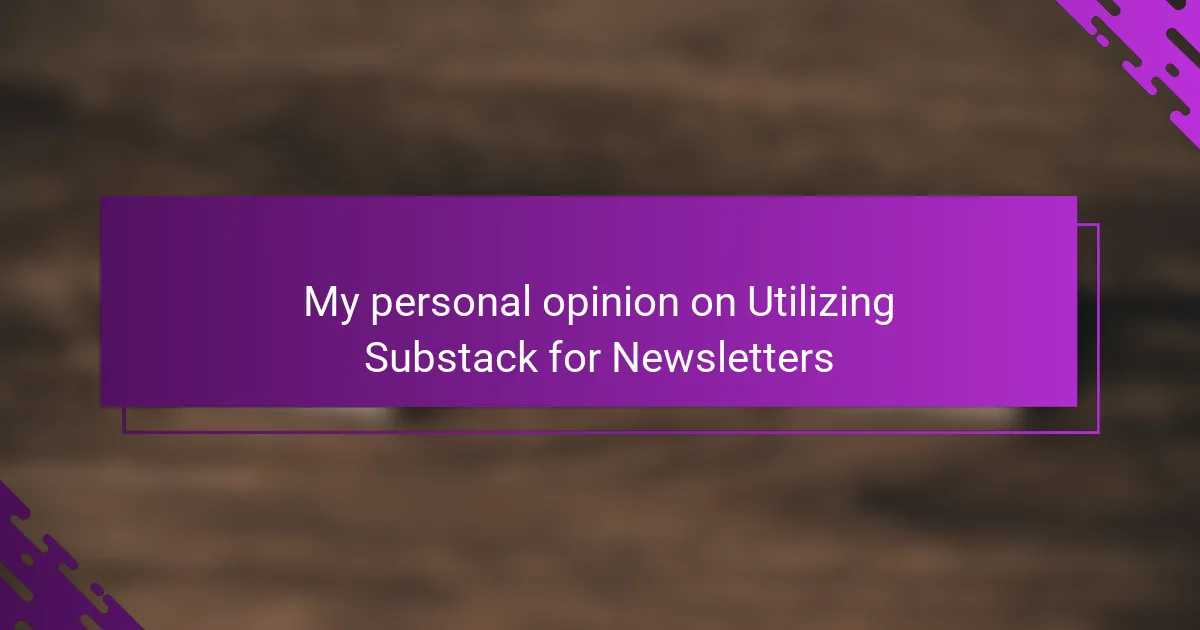Key takeaways
- Substack allows writers to publish newsletters directly, fostering direct relationships with readers without the interference of social media algorithms.
- The platform simplifies monetization with straightforward paid subscriptions, promoting a sense of community and accountability between writers and their audiences.
- Creating engaging content involves mixing personal stories with practical insights to establish genuine connections and keep readers interested.
- Consistency in publishing and actively engaging with readers significantly enhances community building and encourages loyalty among subscribers.
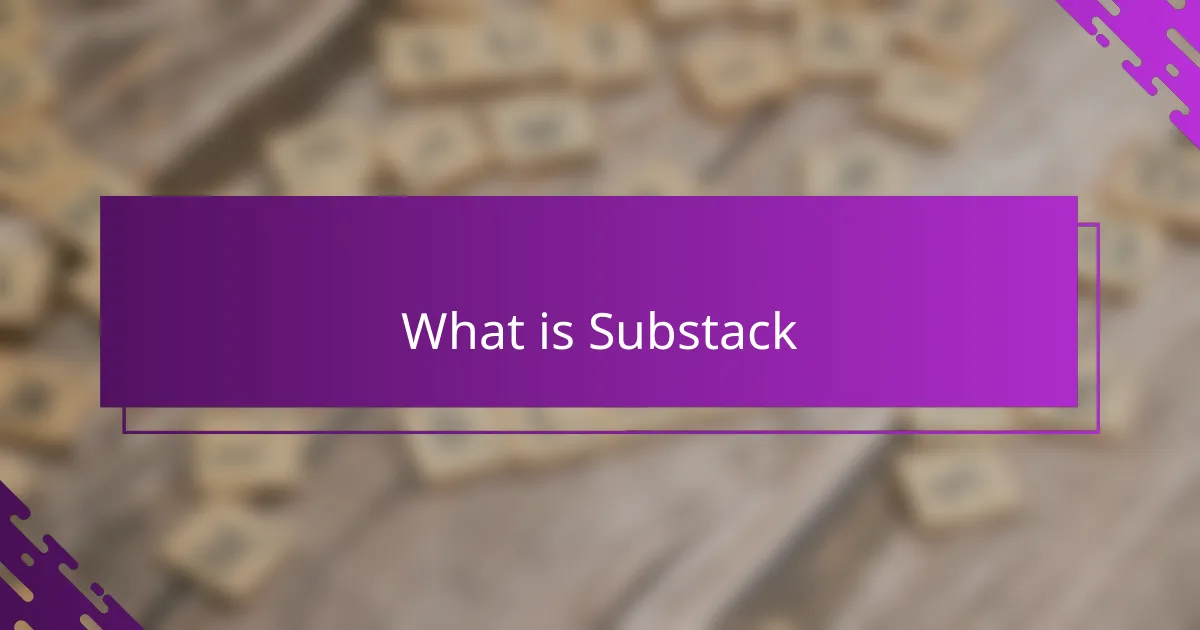
What Is Substack
Substack is a platform that lets writers publish newsletters directly to their audience, cutting out the middleman. From my experience, it feels like having a personal stage where your voice isn’t lost in the noise of social media.
Have you ever wanted to share your thoughts without worrying about complicated websites or algorithms? That’s where Substack shines for me—it’s straightforward and user-friendly, making the entire publishing process feel less like a chore and more like a conversation with friends.
What I find most striking is how Substack empowers writers to build real relationships with their readers, often through paid subscriptions. This direct connection adds a sense of purpose and motivation, turning writing from a hobby into a viable career path.
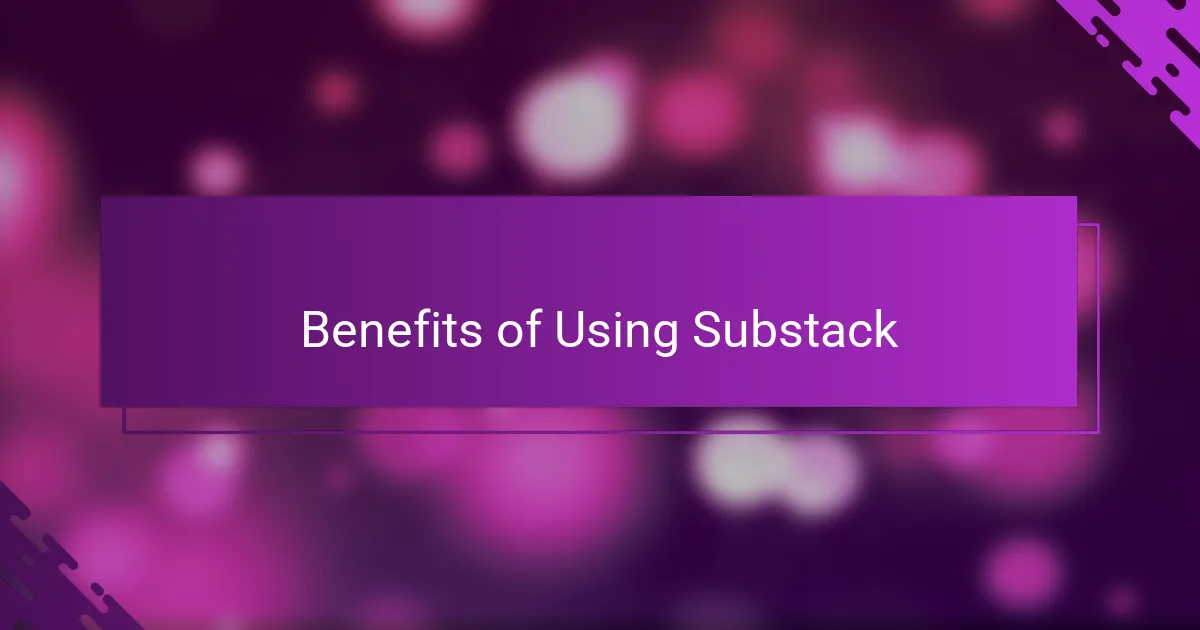
Benefits of Using Substack
One of the biggest benefits I’ve found with Substack is the control it gives me over my content. I don’t have to worry about algorithms deciding who sees my work or if my posts get buried in an endless feed. Knowing exactly where my newsletter goes and how it reaches my readers has made me feel more confident and less frustrated.
Another thing I really appreciate is how Substack makes monetization straightforward without complicating things. When I tried other platforms, figuring out payments and subscriptions was a headache. Here, setting up paid subscriptions felt surprisingly simple, so I could focus more on writing and less on the business side of things.
Have you ever noticed how building a true community around your writing can be challenging? With Substack, I’ve seen firsthand how readers engage more directly—through comments, replies, and even supporting my work financially. This connection has not only motivated me but also made writing feel genuinely rewarding.
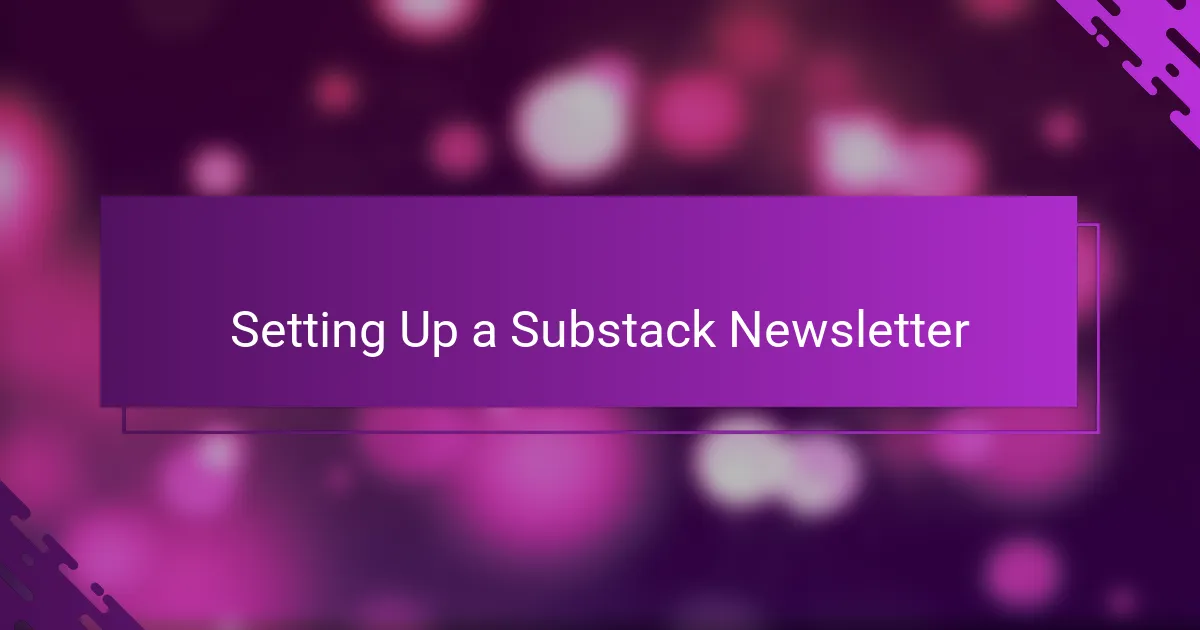
Setting Up a Substack Newsletter
Getting started with setting up a Substack newsletter was surprisingly easy for me. I remember thinking, “Will this be another complicated sign-up process?” But the platform guided me step-by-step, making it feel like someone was holding my hand through it all. It took me less than an hour to have something live and ready to share.
One detail I particularly liked was how customizable the sign-up page is. You can add your own personality with images, descriptions, and even custom domains if you want. It gave me a sense that this newsletter truly belongs to me, not just some generic blog lost in the crowd.
Have you ever struggled with finding the right mix of free and paid content? Substack’s settings made it easy for me to experiment. I started with all free posts, then gradually introduced paid tiers for exclusive content. This flexibility took the pressure off and allowed me to grow at my own pace.
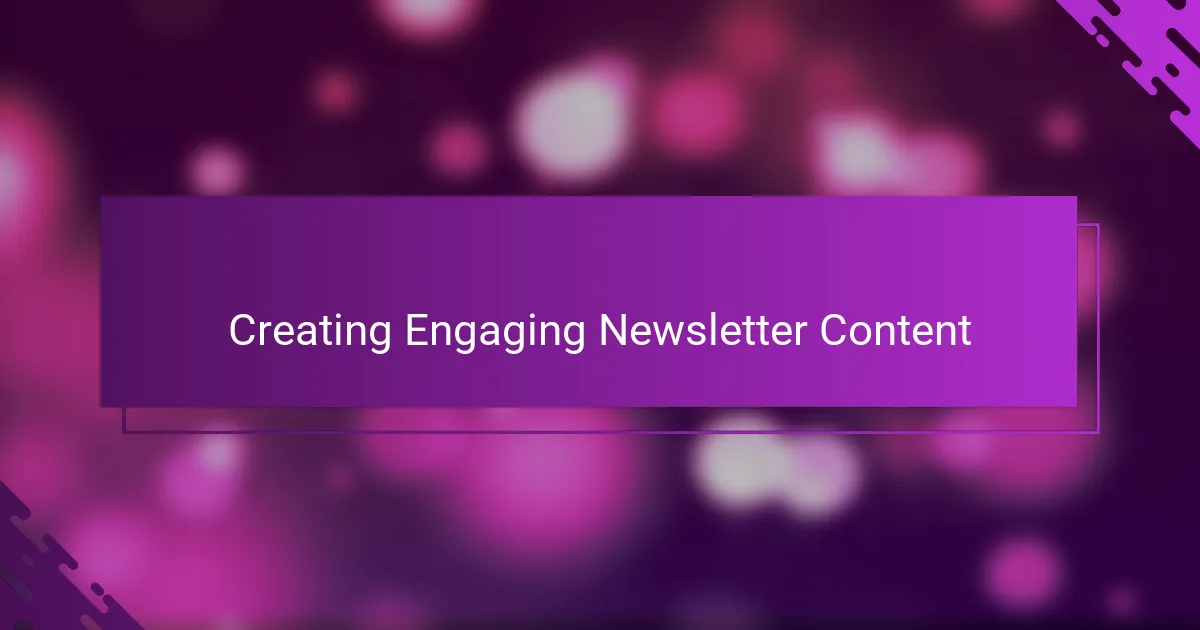
Creating Engaging Newsletter Content
When I create content for my newsletter, I always ask myself: what will truly capture my readers’ attention in their busy inboxes? Over time, I’ve realized that mixing personal stories with practical insights creates a connection that feels genuine, rather than just informational. It’s like inviting someone into a conversation, not just delivering a message.
One trick I found helpful was starting each newsletter with a question or a relatable moment. That little hook immediately grabbed readers and made them want to read more. I remember a time when a simple anecdote about my daily routine sparked a lively discussion in the comments—it reminded me how much storytelling enriches engagement.
Of course, keeping content fresh is key. I try to balance evergreen topics with timely updates, so my readers feel like they’re getting value every time. Does this mean I spend hours perfecting each issue? Not necessarily. Instead, I focus on authenticity and clarity, because when I’m genuinely interested in what I’m sharing, readers sense that and stick around.
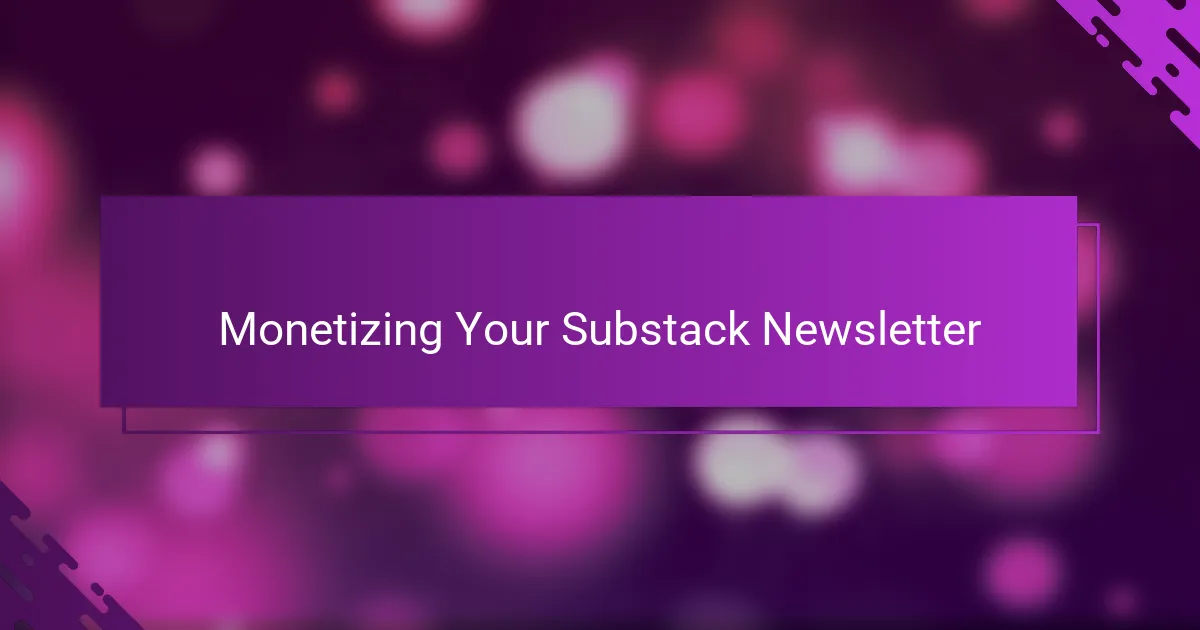
Monetizing Your Substack Newsletter
Monetizing your Substack newsletter felt like a natural step for me, but it wasn’t without its challenges. At first, I wondered, “Will people really pay for my words?” Setting up paid subscriptions was surprisingly simple, yet deciding on pricing took some trial and error. I found that starting small and offering exclusive content made readers feel like insiders rather than just customers.
One thing I appreciate about monetization on Substack is how transparent and straightforward the platform makes it. You don’t get bogged down by complicated ad systems or endless third-party tools. Instead, it’s just you and your audience, exchanging value directly. That kind of connection made me feel more accountable and motivated to keep delivering quality content.
Have you ever felt unsure about how to reward loyal readers? I discovered that offering behind-the-scenes glimpses or early access to posts created a real buzz. It wasn’t just about money; it was about nurturing a community that felt genuinely appreciated. That community spirit, in my experience, is the true backbone of successful monetization on Substack.
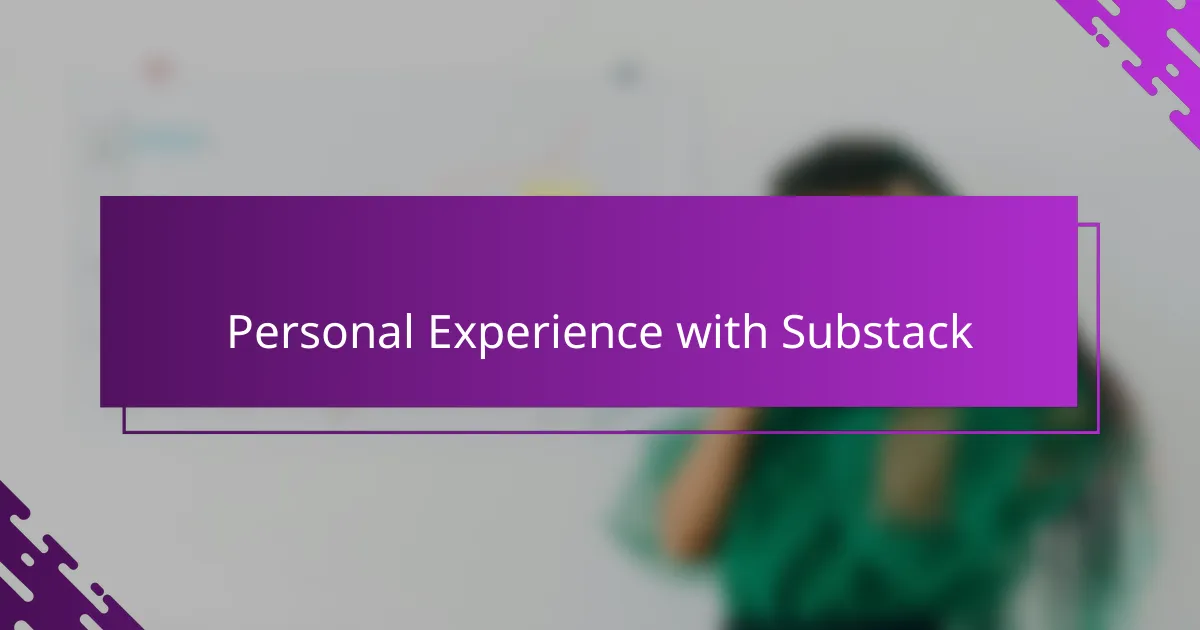
Personal Experience with Substack
When I first started using Substack, I was surprised by how intuitive it felt. The platform didn’t overwhelm me with technical jargon or endless options. Instead, it felt like a simple, welcoming space where I could focus purely on writing and connecting with readers.
At one point, I remember sending out a newsletter that I thought was just another post, but the responses I received made me realize how much people were actually listening. That moment gave me a sense of validation and encouraged me to keep going, especially on days when doubt crept in.
Have you ever experienced the frustration of scattered feedback or lost engagement? With Substack, I found that readers replied directly and often, making interactions feel personal. This ongoing dialogue reminded me why I started writing in the first place—to share ideas and build real connections.

Tips for Success on Substack
One tip I’ve found invaluable on Substack is consistency. Have you noticed how a regular publishing schedule builds trust? I used to struggle with irregular posts, and my reader engagement reflected that. Setting a manageable routine helped me keep readers coming back, turning casual visitors into a loyal community.
Engaging with your readers isn’t just helpful—it’s essential. When I started replying to comments and emails, I realized how much it deepened the relationship. It’s like having a conversation rather than a one-way broadcast, which makes writing feel more rewarding and less lonely.
Finally, don’t be afraid to experiment with your content and format. Early on, I wondered, “What if my style doesn’t resonate?” But trying new ideas—whether it’s long-form essays or quick updates—helped me discover what connected best. This flexibility took the pressure off and made the whole process more enjoyable.
